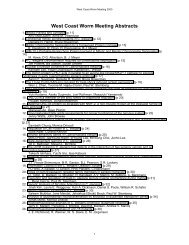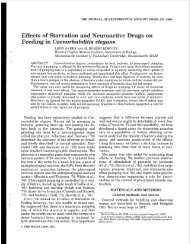Program of the 2004 East Coast Worm Meeting - Caenorhabditis ...
Program of the 2004 East Coast Worm Meeting - Caenorhabditis ...
Program of the 2004 East Coast Worm Meeting - Caenorhabditis ...
Create successful ePaper yourself
Turn your PDF publications into a flip-book with our unique Google optimized e-Paper software.
3. Robust germline amplification and <strong>the</strong> precise timing <strong>of</strong> initial meiosis are dependent<br />
upon interactions with specific cells <strong>of</strong> <strong>the</strong> developing gonadal sheath<br />
Darrell J. Killian, E. Jane Albert Hubbard<br />
New York University, Department <strong>of</strong> Biology<br />
An early step in animal development is <strong>the</strong> establishment <strong>of</strong> <strong>the</strong> germ line, an "immortal" cell<br />
lineage that produces gametes as a means to contribute genetic information to <strong>the</strong> next<br />
generation. In animals as diverse as flies, nematodes, and mammals, <strong>the</strong> adult germ line is a<br />
spatial gradient <strong>of</strong> differentiation from germline stem cells progressing through meiosis to gamete<br />
formation. However, germline development begins from a pool <strong>of</strong> presumably equivalent<br />
primordial germ cells (PGCs). The development <strong>of</strong> <strong>the</strong> germ line from PGCs to a patterned adult<br />
tissue is dependent upon interactions with <strong>the</strong> developing somatic gonad. We are interested in<br />
somatic gonad/germline interactions that influence proliferation and differentiation <strong>of</strong> <strong>the</strong><br />
developing germ line.<br />
In C. elegans, soma/germline interactions occur throughout germline development and can be<br />
studied through genetic and anatomical perturbations. The PGCs, Z2 and Z3, associate with <strong>the</strong><br />
somatic gonad precursor cells Z1 and Z4. This interaction is essential for initial germ cell divisions<br />
and <strong>the</strong>ir competence to differentiate. Later in development, germline proliferation is dependent<br />
on <strong>the</strong> somatic distal tip cell (DTC). Ablation <strong>of</strong> <strong>the</strong> DTC or disruption <strong>of</strong> <strong>the</strong> underlying<br />
LAG-2/GLP-1 signaling pathway results in a loss <strong>of</strong> germline stem cells to meiosis (Kimble and<br />
White 1981; Austin and Kimble 1987). Conversely, constitutive activation <strong>of</strong> GLP-1 leads to<br />
germline hyper-proliferation at <strong>the</strong> expense <strong>of</strong> differentiation (Berry et al., 1997). Yet ano<strong>the</strong>r<br />
germline pattern defect is proximal proliferation (Pro phenotype) characterized by ectopic<br />
germline proliferation in <strong>the</strong> proximal region <strong>of</strong> <strong>the</strong> germ line. Pro mutant germ lines contain, from<br />
distal to proximal, germline stem cells, meiotic cells, gametes, and a proximal germline tumor. In<br />
several Pro mutants <strong>the</strong> germline tumor is derived <strong>of</strong> a subset <strong>of</strong> <strong>the</strong> pre-meiotic germ line that<br />
failed to differentiate (Seydoux et al., 1990; Pepper et al., 2003; Killian and Hubbard <strong>2004</strong>).<br />
We have shown that a reduction-<strong>of</strong>-function mutation in pro-1 results in weak distal germline<br />
proliferation, delayed meiosis, and a highly penetrant Pro phenotype. These phenotypes are due<br />
to loss <strong>of</strong> pro-1 activity in <strong>the</strong> sheath/sperma<strong>the</strong>ca (SS) lineage <strong>of</strong> <strong>the</strong> somatic gonad, not <strong>the</strong><br />
germ line. Consistent with this finding, <strong>the</strong> earliest germline defects in pro-1 mutants are detected<br />
just following <strong>the</strong> division <strong>of</strong> <strong>the</strong> SS cells. Fur<strong>the</strong>rmore, a stronger reduction <strong>of</strong> pro-1 function by<br />
RNAi deletes <strong>the</strong> SS lineage, fur<strong>the</strong>r impairs germline proliferation, but does not cause a Pro<br />
phenotype. pro-1 encodes a member <strong>of</strong> a highly conserved but poorly characterized sub-family <strong>of</strong><br />
<strong>the</strong> WD-repeat containing proteins (Killian and Hubbard <strong>2004</strong>).<br />
Our studies with pro-1 prompted an investigation <strong>of</strong> early SS lineage/germline interactions with<br />
respect to germline proliferation, <strong>the</strong> timing <strong>of</strong> initial meiosis, and <strong>the</strong> molecular function <strong>of</strong><br />
PRO-1. Our time-course analysis <strong>of</strong> coordinate somatic gonad/germline development and our<br />
cell-killing experiments complement and extend earlier findings by McCarter et al. (1997). We find<br />
that <strong>the</strong> distal SS daughter, sheath 1, is in direct contact with mitotic germ cells in <strong>the</strong> L3 and L4<br />
and this contact is crucial for robust proliferation. Sheath 1 does not contact <strong>the</strong> mitotic germ line<br />
in adults (Hall et al., 1999) when <strong>the</strong> germline is in a steady state. In addition, we find that<br />
ablation <strong>of</strong> <strong>the</strong> proximal daughter <strong>of</strong> <strong>the</strong> SS cell, <strong>the</strong> precursor to sheath 2-5 and sperma<strong>the</strong>cal<br />
cells, delays <strong>the</strong> onset <strong>of</strong> meiosis in <strong>the</strong> germ line. Toge<strong>the</strong>r, our results support important and<br />
antagonistic roles <strong>of</strong> <strong>the</strong> SS daughter cells in early germline pattern formation. We are also<br />
investigating <strong>the</strong> role <strong>of</strong> PRO-1 with respect to <strong>the</strong> function <strong>of</strong> <strong>the</strong> SS lineage cells. The S.<br />
cerevisiae ortholog <strong>of</strong> pro-1, Ipi3, has been implicated in <strong>the</strong> rRNA processing step <strong>of</strong> ribosome.<br />
Our genetic analysis supports an analogous role for PRO-1. Up-regulation <strong>of</strong> ribosome<br />
biogenesis via mutation in ei<strong>the</strong>r ncl-1 or lin-35/Rb significantly rescues pro-1(na48) germline<br />
pattern defects. Defects in ribosome biogenesis have been linked to both inhibition <strong>of</strong> cell growth<br />
and cell cycle arrest. We are currently investigating a potential developmental control <strong>of</strong> ribosome<br />
biogenesis related to <strong>the</strong> functions <strong>of</strong> <strong>the</strong> SS lineage cells and germline patterning.




